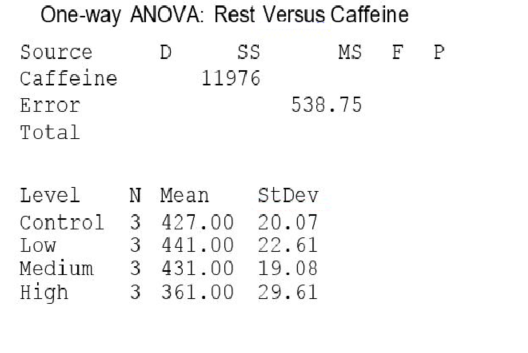Investigators gave caffeine to fruit flies to see if it affected their rest. The four treatments were a control, a low caffeine dose of 1 mg/ml of blood, a medium dose of 3 mg/ml of blood, and a higher caffeine dose of 5 mg/ml of blood. Twelve fruit flies were assigned at random to the four treatments, three to each treatment, and the minutes of rest measured over a 24-hour period were recorded. Assume the data that follow are four independent SRSs (one from each of the four populations of caffeine levels) and that the distribution of the yields is Normal.  A partial ANOVA table produced by Minitab follows, along with the means and standard deviation of the yields for the four groups.
A partial ANOVA table produced by Minitab follows, along with the means and standard deviation of the yields for the four groups.  For this example, we notice that:
For this example, we notice that:
A) this is an observational study.
B) the data show evidence of a violation of the assumption that the four populations have the same standard deviation.
C) ANOVA can be used on these data because ANOVA requires the sample sizes are equal.
D) None of the answer options is correct.
Correct Answer:
Verified
Q8: A company conducted an experiment to investigate
Q9: The alternative hypothesis for the one-way analysis
Q10: Investigators gave caffeine to fruit flies to
Q11: Investigators gave caffeine to fruit flies to
Q12: At what age do babies learn to
Q14: Investigators gave caffeine to fruit flies to
Q15: A company runs a three-day workshop on
Q16: Investigators gave caffeine to fruit flies to
Q17: A traffic engineer wanted to study
Q18: A traffic engineer wanted to study the
Unlock this Answer For Free Now!
View this answer and more for free by performing one of the following actions

Scan the QR code to install the App and get 2 free unlocks

Unlock quizzes for free by uploading documents